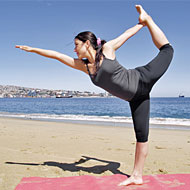- Aromatherapy (36)
- Benefits of Yoga (282)
- Home Remedies (1087)
- massage therapy (9)
- Preventive Therapy (135)
- Running (41)
- Skin Care (15)
- Stress Relief (25)
- Stretching (5)
- walking (33)
- Womens Health (14)
- Yoga Benefits for Pregnant Women (16)
- Yoga Benefits for Students (3)
- Yoga for Children (11)
- Yoga for Holistic Living (37)
- Yoga for Midlife Crisis (3)
- Yoga for Senior Citizens (2)
- Yoga for the Workplace (1)
- Yoga Health Tips (185)
- Yoga Practice during Menstruation (5)
Bikram Yoga Vs Iyengar Yoga For Knee Issues

Bikram Yoga and Iyengar Yoga are two different styles of yoga developed by Shri Bikram Choudhuri and Shri B.K.S. Iyengar respectively. It is important to understand that the yoga postures practiced are universal to all types of yoga. Only the method of practice is different having been developed by each of them with distinctive characteristics.
Iyengar Yoga is a combination of 200 yoga postures and 14 types of breathing techniques. It is based on the traditional eight limbs of Patanjali Yoga. They have been structured in such a way that it becomes easier for beginners to gradually progress from simple to difficult physical postures. The thrust is on developing strength, stamina, flexibility and balance. Iyengar yoga emphasizes on body alignment. There is a correct way of doing each pose and perfection can be achieved through practice. The emphasis is on standing asanas. Standing poses build strong legs, improve circulation, coordination and balance ensuring a strong foundation for advanced poses. Props are used to enable students to adjust and practice postures safely and effectively. The objects like benches, blocks, chairs, cushions, blankets, straps help beginners to practice poses easily and fully. Even those having ailments and experiencing weakness find the props to be effective support for practicing postures without requiring muscular effort. The props help in finding the ideal alignment when the body is not flexible enough.
Bikram Yoga is practiced in a hot room, having a temperature of 105 degrees Fahrenheit, to minimize the risk of injury, allow for deep stretching and release of unwanted toxins. This style of practice warms and stretches every joint, muscle, ligament, tendon, vertebrae and organ of the body. It consists of 26 poses and each pose is practiced twice. You have to hold each pose for some time. It starts from standing to back bending, front bending and twists. The poses are followed by Kapalbhati.
Both Bikram Yoga and Iyengar Yoga have been effective in treating knee problems. Knee issues can include osteoporosis of the knee, a degenerative disease when cartilage decays gradually. It becomes dry and brittle. Cartilage is like a sponge which cushions the bone. This problem is currently more prevalent. You can also have damaged ligaments.
The yoga poses which are effective for knee problems are -
Tadasana (The Mountain Pose), Trikonasana (Triangular Pose), Janu Sirshasana (Head to knee pose), Dhanurasana (The Bow Pose), Supta Vajrasana (The Reclining Adamant Pose), Ardha Matsyanderasana (The Half spinal Twist Pose), Kurmasana (The Tortoise pose), Mandukasana (The Frog Pose), Virasana (The Warrior Pose), Gomukhasana (The Cow Pose), Garudasana (The Eagle Pose), Virbhadrasana (Virbhadra Pose) amongst many others.
Keeping in perspective that both Bikram Yoga and Iyengar Yoga include yoga postures and breathing techniques which act as an antidote to knee problems, it will not be fair to draw a comparison. The onus of selecting either of these styles depends on your, based on individual capacity, inclination, and personal preference. One needs to be committed and regular practice of yoga not only reduces knee problems, but degenerative symptoms get arrested. Irrespective of what style you chose, whether it is Bikram Yoga or Iyengar Yoga, it is imperative to make sure that your instructor is familiar with your ailment and will see you through recovery process.
- RSS Feeds -
- All posts
- All comments
- Getting to Know Iyengar Yoga Every day there are new yoga classes opening in some part of the world. Peopl...
- Dangers Of Bikram Yoga Bikram yoga is a type of hot yoga which has been patented by Bikram Choudhury...
- Chest Pains after Bikram Yoga Bikram yoga is a collection of traditional yoga techniques and has acquired i...
- Bikram Yoga Training Places Step up to 'hot' YogaWhen Bikram Choudhury synthesized tradi...